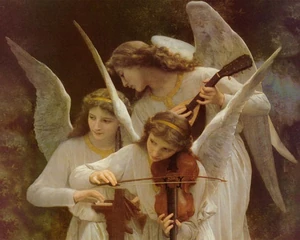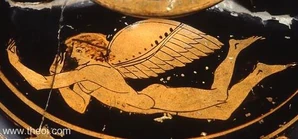Angel (Greek: angelos, meaning "messenger", Persian: angaros, "courier") is traditionally believed to be supernatural beings who serve as messengers or mediators between man and primordial gods. As such, they are often depicted in religious works and mythologies as winged humanoid beings. The winged human motif stems as far back as the Sumerian civilization, and possibly earlier. The earliest known record, dating c. 10,000 BCE, of ritualistic activity involving a religious center is Gobekli Tepe where headless pillars have anthropomorphic features that might represent some type of spirit medium.
Ancient aliens[]
The Ancient Aliens hypothesis postulates that what was seen as “angels” were really extraterrestrials.
Jinn[]
Although viewed as free-willed spirits in Islamic culture, the Kurds believed Jinn to be angelic servants who settled in mountainous regions and married human women. Their offspring came to be known as the Kurds.[6]
Tuath Dé[]
In ancient Irish legend, the Tuath Dé (Irish: "tribe of the gods"[7] dwell in the Otherworld and interact with humans in the human-world. With the advent of Christianity,[8] the Tuath Dé were banished into the 'hollow hills' and became known as Sidhe (Shee), meaning “Shining Ones”. According to Lebor Gabála Érenn, they came to Ireland "in dark clouds" and "landed on the mountains of [the] Conmaicne Rein in Connachta".[9]
Watchers[]
From the Levant, one of the oldest Semitic expressions on preserved record, referring to angel(s) is the Aramaic term Watcher (Aramaic: עִיר ʿiyr, plural עִירִין ʿiyrin, Slavonic: Grigori).[10] The term occurs in the Books of Enoch (2nd–1st centuries BCE) referring to both good and bad Watchers, with a primary focus on rebellious ones. It also occurs in both plural and singular forms in the Book of Daniel where reference is made to their holiness.[11]
Popular culture[]
- The Syndicate in the Dissension Universe by Aspen Comics.
- Angels are present as extremely advanced ethereal creatures from the planet Lucifer in the Doctor Who novel Lucifer Rising.
- Proginoskes the Cherub from Madeline L'Engle's A Wind in the Door.
- In Star Wars: The Phantom Menace, the young Anakin Skywalker has heard stories from space travelers about "angels" who live in the moons of Iego and described them as the most beautiful creatures in the universe. He initially believes that Padmé Amidala is one of them.
- Pit (from the Kid Icarus series) is an angel who, ironically, can't fly on his own.
- In Babylon 5, the angels of Human folklore, along with many similar creatures from other species' myths, were actually an appearance assumed by the Vorlons to help guide these races' developments.
- Gordon "ALF" Shumway is apparently familiar with them, as he once told Kate that her silhouette in the shower resembles that of an angel. A naked angel, he adds, much to her discomfort. In another episode, ALF is visited in his dream by an angel named Bob.
- Angels are known to exist in the DC Multiverse, a notable example being Zauriel.
- Angels are a key supernatural species in the TV show Supernatural, the main angel being Castiel. These angels are heavily based on the Judeo-Christian account of angel mythos. These angels are depicted in a very family-oriented way, with angels being siblings to one another and referring to God as their Father.
- In the 2013 video game DmC: Devil May Cry, angels are a supernatural race which has waged an eternal war with their demon counterparts. Dante, the protagonist of the story, along with his brother, Vergil, are Nephilim; a hybrid of angel and demon. These angels, as well as the demons, do not follow any particular religious or spiritual mythos but are instead depicted in a very Western form with angels being benevolent beings and demons being shown as filling the roles of real-world evils or "societal ills" (bankers, politicians, club owners, media personalities, celebrities, etc.).
- The amorphous form of Viewers somewhat resembles a biblically accurate depiction of a throne.

Three angels as portrayed by William-Adolphe Bouguereau in his Song of the Angels (1881)

In antiquities, angels were portrayed as male beings.
See also[]
Several species using the name angel:
- Angels from Planetary
- Angel Hair from Orion's Arm
- Ash Angels from Star Wars
- Death Angels from A Quiet Place
- Diathim, a.k.a. "Angels" from Star Wars
- Wake Angels from Titan A.E.
- Weeping Angels from Doctor Who
- Maykrs from Doom Eternal.
Notes[]
- ↑ In a late Zoroastrian tradition (c. 6th century BCE), Zoroaster's mother, Dughdova, was a virgin when she conceived Zoroaster by a shaft of light.
Sources[]
- ↑ Hinduism: The Ideas of Heaven and Hell, by Swami Adiswarananda
- ↑ Giants Of Sumer, by Xavier Séguin, March 8, 2014
- ↑ Encyclopedia Judaica: Anthropomorphism
- ↑ The Mesopotamian Pantheon, ABGAL
- ↑ The Popular Encyclopedia of Apologetics, by Ed Hindson, Ergun Caner, p. 501, Zoroastrianism
- ↑ Kahn, M. (1980). Children of the Jinn: in Search of the Kurds and their Country. Michigan: Seaview Books, pp. xi.
- ↑ Koch, John T. Celtic Culture: A Historical Encyclopedia. ABC-CLIO, 2006. pp.1693-1695
- ↑ W. B. Yeats (1888). Fairy and Folk Tales of the Irish Peasantry. p.1
- ↑ www.sengoidelc.com - Quotations from early Irish Literature
- ↑ Orlov, Andrei A. (2011). Dark mirrors : Azazel and Satanael in early Jewish demonology. Albany: State University of New York Press. ISBN 1-4384-3951-2., p.164
- ↑ Wikipedia, Watcher (angel)